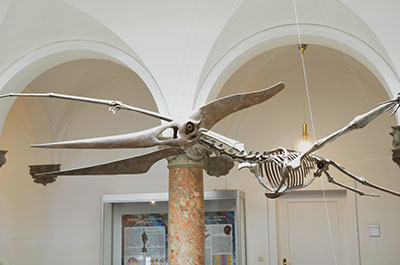Giant Pterosaur
Pteranodon longiceps

Niobrara-Formation and Pierre Shale,
Late Cretaceous: Santonium–Campanium, approx. 86 to 72 Mio. years old
West Kansas, USA
The pterosaurs are a distinct evolutionary line of archosaurs (“reigning reptiles”), close to but not belonging to the dinosaurs, and thus only distantly related to modern birds. They were the first actively flying vertebrates, with wings consisting of a flying skin stretched from the severely elongated fourth finger of the hand. While the first pterosaurs were rather small animals about the size of a crow, giant forms evolved in various groups during the Cretaceous.
Pteranodon attained a wingspan of up to 7 m, lived along a shallow sea that stretched through the midwestern United States at that time, and probably fed primarily on fish. There were even larger pterosaurs, with wingspans presumably up to 12 meters. However, due to an extreme lightweight construction – the bones were very thin-walled and filled with air – the live weight of even a giant pterosaur like the Pteranodon shown here was probably less than 75 kg.
SNSB-BSPG
Skelettrekonstruktion